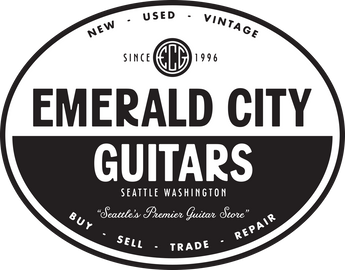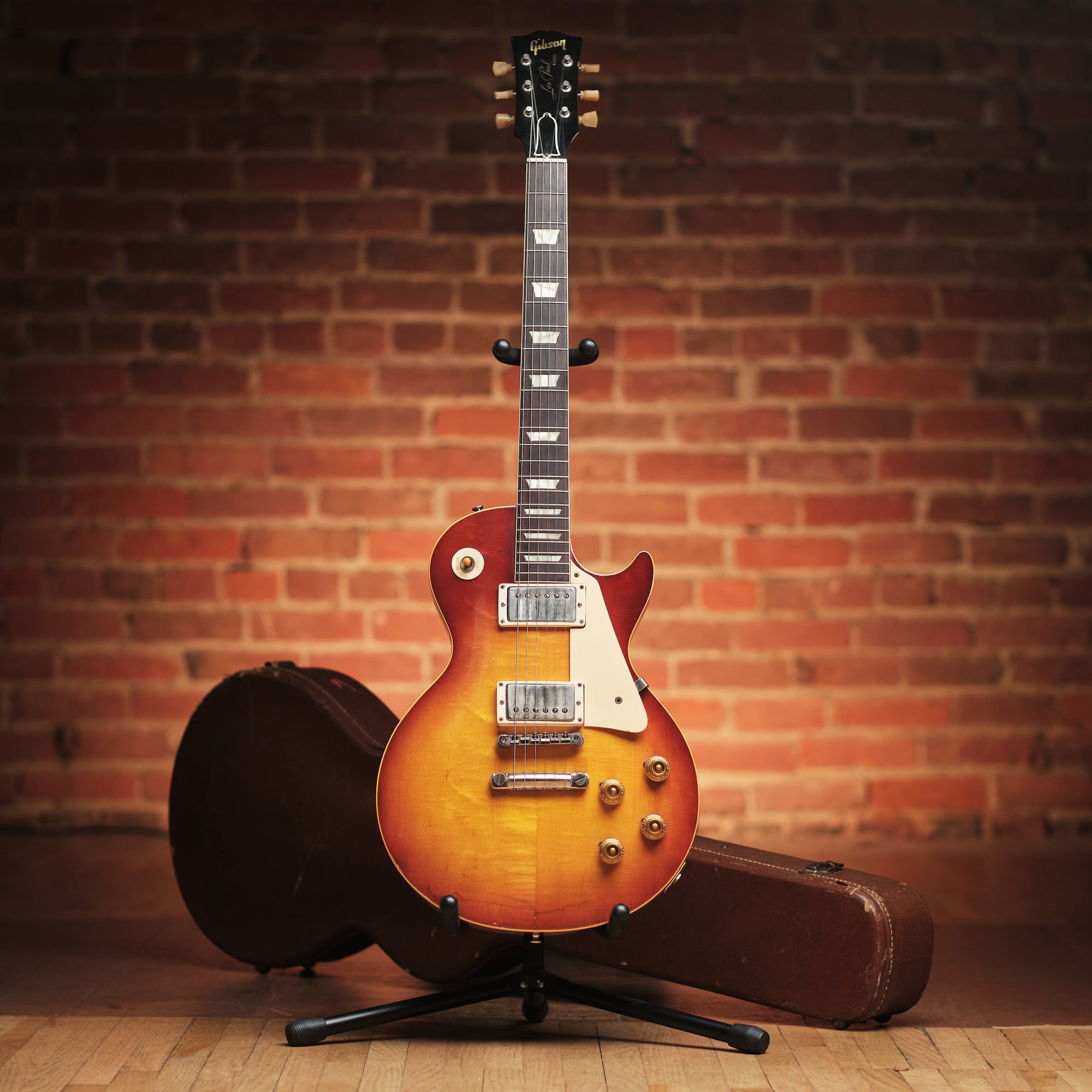1954 Gibson Les Paul


An unpopular opinion, of which I have many: the 1954 Les Paul is the most technically superior configuration in the entire history of the model. The P-90s are criminally underrated, as I’ve been vocal about in the past. Any golden-era rock, blues, and R&B tones imaginable can be absolutely nailed with these. The wraparound stop tail bridge is another important piece the puzzle. Often overlooked because of its brief usage, I believe it to be far preferable tonally to the later tune-o-matic. Greater mass, longer sustain, glassy clarity. It accentuates all the characteristics for which we already love Les Pauls. Its chunky C neck sits somewhere between a ’58 and ’59 profile, an absolute dream as far as I’m concerned. There’s not much to complain about.
Mint guitars are great, but it always warms the heart to see an excellent guitar that has been played and appreciated in decades past. This Lester has seen some heavy use but never abuse, and remains mostly original. A replacement nut and volume pot are the extent of the aftermarket components. No breaks, repairs, or other such tragedies to note. As far as dollar-for-dollar value, I don’t know that there’s a more attractive option in today’s vintage guitar market than an issue-free ’54 Les Paul. I tend to resist picking favorites, but I would likely reach for this guitar before the vast majority of LPs that have graced my bench in recent years.
1979 Zemaitis


I’m shocked to admit that the guitars of the late Tony Zemaitis have been growing on me recently. In the same way you may start to warm up to your sister’s drug dealer boyfriend after several months. Maybe begrudging acceptance is the term. Either way I’m in full support of the rat-tail sleaze this thing exudes. It was built in ’79, and only just predates the company’s aesthetic shift towards aggressive pearl mosaics and gratuitous fleurs de lis. This metal top does feature a tasteful amount of gunstock engraving, but is a far cry from the Ed Hardy-esque gaudiness that was soon to gain favor in the marketplace.
The initial purpose of the metal top was to mitigate as much hum as possible. This solution had marginal success, but once the idea was validated by players such as Ronnie Wood and Eric Clapton, the orders came quicker than Tony could build. He ran what would now be considered a custom shop long before companies like Fender and Gibson monopolized the term. His output was notoriously limited, with a waiting list that continued to elongate from the early 70s until his death in 2002. You just don’t see these early models come up for sale often. Once they’re snatched up they tend to remain in collections for a lifetime. Holding one in your hands, the reasoning behind the obsession comes obviously into focus. It’s every bit as much a piece of folk art as it is an instrument. A true piece of rock history, and representative of an unthinkably bold leap in the progression of the electric guitar by small-shop luthiers.
1957 Gibson Les Paul


As ubiquitous as rockstars become, it takes an incredible amount of exposure to make a guitar tech famous. If anyone has ever made a name for themselves swinging a fretting hammer, it would have to be the legendary Cesar Diaz. With a resume that includes road work for players such as Stevie Ray Vaughan, Bob Dylan, Eric Clapton, Neil Young, and Kieth Richards, it’s safe to say that this guy is a connoisseur of guitar tone. What an endorsement, then, to have a blue chip 50s Gibson with an ownership history connected to the most credited guitar/amp tech to ever pull a wrench. Not that my opinion carries much weight in comparison, but I’d agree that this Les Paul is worth buying.
This Lester is an extremely early ’57 model, within only a couple hundred serial numbers of the last P-90 Goldtop ever made. This guitar features the earliest version of the iconic Gibson PAF, known as the “no sticker” humbucker. They are astonishingly bright and clear when compared to modern dual-coils, much more akin to Fender pickups of the era. The frets have been masterfully replaced, but the rest of the guitar remains completely original apart from some minor finish fills on the back on the neck. I’m sorry to say that this guitar sold mere minutes after arriving at the shop, but I’m certain that tales of this legendary instrument will be repeated at the shop for years to come.
1957 Fender Stratocaster


Refinished vintage guitars tend to get painted with a broad aftermarket brush. The conventional wisdom used to be that losing the original finish would result in the halving of the market value. This was always a tenuous estimation and rarely proves to be accurate, especially today. The reality is that all refinishes were not created equal. The age, quality, and accuracy of a refinish can make a difference in price to the tune of five figures on some instruments.
This particular refinish checks all the boxes. No matter how skillfully applied there is simply no way to beat an ancient refin, and we estimate that this one occurred some time in the first several years of the guitar’s life. Natural shrinking, checking, and general wear are unmistakable and can never be truly replicated on an abbreviated timeline. The finishing style and schedule appear to be very similar to that of Fender’s, and I’m quite sure it could pass for an original finish to even the most keen-eyed vintage enthusiast. Finish aside, it is an alarmingly original example of one of the Strat’s hallmark years. Some light overspray on the neck and a replaced nut are the only other amendments, but also appear to be from decades past. An original ’57 Strat in Dakota red would easily set you back six figures, and I’d wager it wouldn’t be as nice as this one.
1953 Gibson Les Paul


Early Les Pauls, despite their historical significance, have always been and continue to be a relatively tough sell for most vintage guitar enthusiasts. Most new models in their infancy struggle with growing pains and go through a series of tweaks within their first several years of production, some more extensively than others. In the world of guitar design blunders, though, Gibson’s wrap-under tailpiece found on early LPs takes the cake for the most egregious. The guitars simply were not playable for most musicians. Many have been permanently altered and many more simply thrown away over the years, and have only recently been redeemed by the advent of an ingenious aftermarket tailpiece designed specifically for the model. These new tailpieces allow the strings to wrap over the top, effectively making a completely playable vintage guitar out of what used to be a nice-looking piece of midcentury furniture.
Apart from this new tailpiece, this example is entirely original and unmolested. (The original tailpiece is included) Perhaps the most striking feature of this particular guitar is its astonishing lack of mass, weighing in at exactly 8.5 lbs. This is nearly unheard of for a Les Paul, especially these early models. The result is a tremendously resonant and acoustically loud instrument, again, not at all the norm in ’53. Because of their eccentricities, early models were generally either abused out of frustration or kept in their case and forgotten. This instrument was surely one of the latter, the condition is truly hard to believe. If you can put the stigmas of the past aside, this is an excellent vintage Les Paul that can go up against any from Gibson’s golden era, and can be had for a fraction of the price of a mid-50s model



